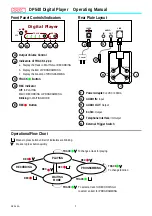
Media (iSCSI) network description
The media network is exclusively for real-time iSCSI traffic on a K2 SAN. It must be on a different
subnet than the control network and the streaming/FTP network. Furthermore, its traffic is kept
physically separate from that of other networks. This separation is provided by dedicated ports,
cables, and by a dedicated VLAN on the Ethernet switch or by separate switches. Static IP addresses
are required for the media network. Name resolution is not necessary, so media network IP addresses
are not required in host files.
The media network applies to online K2 SANs. Nearline K2 SANs do not have a media network.
Redundant K2 SANs have redundant media networks: an A media network and a B media network.
The two networks are on separate subnets and are also physically separated onto the A Ethernet
switch and the B Ethernet switch. InterSwitch Links (ISLs) between switches do not carry media
(iSCSI) traffic. ISLs provide redundant paths for control network traffic and streaming/FTP network
traffic only.
Devices are on the media network as follows:
•
Shared Storage K2 client - On a non-redundant K2 SAN, the A media port connects to the media
network. On a redundant K2 SAN, the A media port connects to the A media network and the
B media port connects to the B media network.
•
K2 Media Server - A server has one port available for connection to a media network. This is a
10 Gig iSCSI interface adapter, which supports the functionality of a TCP/IP Offload Engine
(TOE). On a redundant K2 SAN, one server is on the A media network and one server is on the
B media network.
Networking tips
•
Before configuring any devices for networks, determine the full scope of IP addresses and names
needed for the all the machines in your system. Work with the network administrator at your
facility to have IP addresses and names available for your use.
•
It is recommended that you use the patterns offered in SiteConfig by default to establish a
consistent convention for machine names and IP addresses. You can plan, organize, and enter
this information in SiteConfig as you develop a system description. You can do this even before
you have devices installed and/or cabled.
•
On 64-bit devices, configure IPv4 addresses. Disable the IPv6 interface of the Control and FTP
interfaces. SiteConfig always configures IPv4 addresses for 64-bit devices.
Network considerations and constraints
•
Do not use any 10.1.0.n IP addresses. These are used by the K2 RAID (NEC Condor) maintenance
port and must be reserved for that purpose. If these addresses are otherwise used, maintenance
port communication errors occur.
44
K2 SAN Installation and Service Manual
02 February 2012
Preparing for installation
Summary of Contents for K2 BASECAMP EXPRESS
Page 28: ......
Page 38: ......
Page 62: ......
Page 112: ......
Page 124: ......
Page 248: ...248 K2 SAN Installation and Service Manual 02 February 2012 Operating the K2 SAN ...
Page 256: ......
Page 340: ......
Page 354: ......
Page 366: ...366 K2 SAN Installation and Service Manual 02 February 2012 Index ...
















































